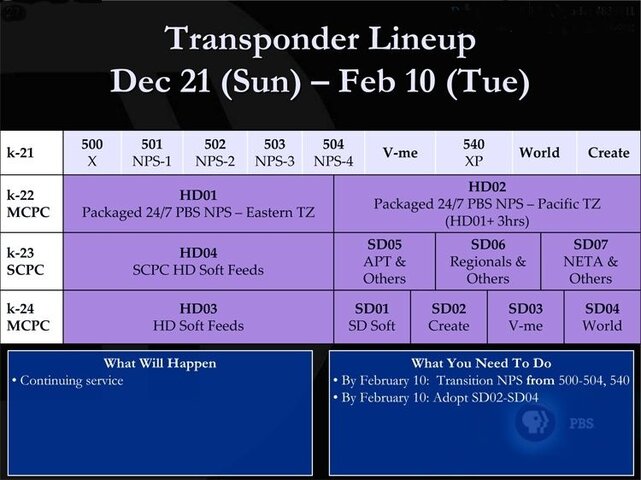My Scientific Altanta has different tuning modes to try to extract the channels from the multiplex. Proper Powervu multiplexes require a NIT, I guess. I changed the tuning mode to FTA, and now it's in "degraded" mode, and will pull out the channels, but the channel name just shows "Name Unavailable". I have it tuned to the HD multiplex right now and it also contains no NIT. It seems to contain PSIP information, which the IRD cannot read. I have the ASI output connected to a QAM modulator and use a ATSC/QAM tuner to watch HD. The one PBS HD channel comes up with a channel name on my ATSC/QAM tuner, which tells me it contains PSIP information. That channel is probably for broadcasting directly over ATSC because it seems to be an ATSC multiplex.
Jonathan
Re containing PSIP info that the IRD isn't reading, I'm guessing that it just isn't there. Some of the PBS feeds have the PIDs that would normally have such info, but there isn't much meaningful in them.
I'm not sure when things changed, but I just noticed that the different PBS transponders now seem to be encoded differently. I *THINK* that they used to be all the same, in the simulated ATSC format, with very little info in many PIDs. However I just now looked at 12120, 12140, and 12180, with TSREADER, and they're different.
The 12180 transponder is a very simple DVB type transponder, with just PAT,PMTs, A/V streams. It's not trying to simulate ATSC, and it doesn't have any SDT, NIT, EITs, or anything else with textual info. No channel names at all in this mux, just the numbers.
The 12140 transponder seems to be in the simulated ATSC format. There is an EIT stream, but it doesn't have much except
*******************************
Starts: 12/19/2008 6:59:46 AM
Length: 03:00:00
EIT Source: EIT0
Name: PBS HD Program
Description: n/a
Descriptor: ATSC Caption Service Descriptor
ATSC Caption Service Descriptor:
Language: eng Format: Line 21 captions from Even field
Language: eng Format: Captions service 1
Descriptor: ATSC AC-3 audio Descriptor
ATSC AC3 Descriptor
*******************************
That's all, and the length data is even wrong.
For the channel 3, it has a TVCT PID, which has the following:
**********************************
Channel 3
Service Name: PBS1DTV
TSID: 1 (0x0001)
Channel Number: 80.3
Carrier Frequency: 0
Modulation Mode: ATSC (8 VSB)
Source ID: 3
Channel ETT: PBS HD Channel
Descriptor: ATSC Extended Channel Name Descriptor
Extended Channel Name: PBS1DTV 1
Descriptor: ATSC Service Location Descriptor
Service Location Descriptor:
PCR PID 49
Stream Type 0x02 (MPEG-2 Video) ESPID = 49 Language =
Stream Type 0x81 (AC-3 Audio) ESPID = 52 Language = eng
Stream Type 0x81 (AC-3 Audio) ESPID = 53 Language = spa
*************************************
TSREADER apparently picks up the channel names from this.
For some reason, as I was about to repeat the above for the 12120 transponder, my receivers seem to have completely lost all the horizontal channels for some reason, so I can't look at that now, but I *THINK* that before I lost it, that it was in the simulated ATSC mode. Weird that I lost the H signal from 2 different dishes. I'm hoping that I didn't run over the coax with my snowmobile.
But in any event, I don't think there is much textual info included on the PBS muxes, even when they include the streams.
EDIT: About a half hour after writing the above, the horizontal channels came back (I have no idea of what happened).
Anyway the 12120 transponder is in that simulated ATSC mode, and has even less info than the 12140 transponder. For example the EIT has:
******************
Channel 1
Service Name:
Provider Name:
Transport Stream ID: 1 (0x0001)
---------------------------------------------
Starts: 12/19/2008 9:59:47 AM
Length: 03:00:00
EIT Source: EIT0
Name:
Description: n/a
********************
which describes a channel that isn't even on the mux, and doesn't have any info anyway.
There is a CVCT section, but it has almost nothing, and what's there is incorrect.
So basically there isn't any accurate textual info on the mux that I can see.


